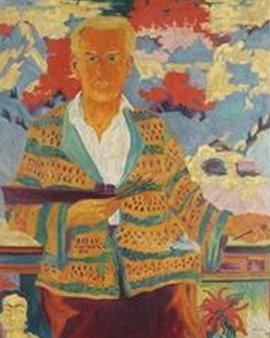Philipp Bauknecht was born in 1884 into a Württemberg watchmaking family, but spent the first ten years of his life in Barcelona, Spain. However, the expressionist painter and graphic artist ultimately moved to Davos, Switzerland, where the majority of his works were created. Here Bauknecht also encountered numerous artistic influences, which subsequently had a lasting effect on his work. At first, however, the reason for his move to Davos was not very pleasant. In 1910, the painter fell ill with tuberculosis and sought recovery from his illness in the recognized climatic spa. There he came into contact both with the high society of the rich and intellectual guests in the spa facilities and with the hard and adverse living conditions of the rural population in the mountains. He uses both influences in his paintings and woodcuts.
Bauknecht also made contact with personalities in Davos who influenced his artistic work and style. Among them were the art historian Erwin Poeschel and one of the most important German expressionists: Ernst Ludwig Kirchner. Some similarities can be seen with his work and initially there was also an intensified collaboration between the two. Later, however, the relationship failed due to different and incompatible lifestyles. Thanks to his good contacts but of course also because of his above-average talent, Bauknecht was able to organize exhibitions of his paintings and woodcuts in Switzerland and Germany throughout his life. After Bauknecht died at a very young age in 1933 during an operation in Davos, his works had to be hidden from the Nazi henchmen and fell into oblivion. New enthusiasm for his work was only rekindled in the 1960s with renewed exhibitions.
Philipp Bauknecht is characterized by a colorful, compositionally relaxed expressionist style. At the beginning of his artistic career he was still influenced by Late Impressionism and Art Nouveau, but in the Swiss seclusion he was able to consistently find his own expressionist style. The alpine landscape and rural simplicity around Davos are always at the centre of his works, conveying a sense of originality and shifting the focus to elementary human feelings and actions. He often creates fantastic landscapes that manifest a harmony between man and nature. The landscape is often depicted highly compressed to the existential and is characterised by strong colour contrasts. However, Bauknecht is far from idealising or romanticising life in the mountains. He takes much more pleasure in the grotesque and bony exaggeration of the peasant mountain people. But he always breathes life into this simple and poor existence through a colourful and exciting colour scheme.
×





.jpg)
.jpg)
.jpg)
.jpg)
_-_(MeisterDrucke-690973).jpg)
_-_(MeisterDrucke-690973).jpg)
.jpg)
.jpg)
_-_(MeisterDrucke-693447).jpg)
_-_(MeisterDrucke-693447).jpg)
_-_(MeisterDrucke-693430).jpg)
_-_(MeisterDrucke-693430).jpg)
.jpg)
.jpg)
.jpg)
.jpg)
.jpg)
.jpg)
.jpg)
.jpg)
.jpg)
.jpg)
.jpg)
.jpg)
.jpg)
.jpg)
_-_(MeisterDrucke-693334).jpg)
_-_(MeisterDrucke-693334).jpg)
.jpg)
.jpg)
_-_(MeisterDrucke-693335).jpg)
_-_(MeisterDrucke-693335).jpg)
.jpg)
.jpg)
.jpg)
.jpg)
_-_(MeisterDrucke-693718).jpg)
_-_(MeisterDrucke-693718).jpg)
_-_(MeisterDrucke-693748).jpg)
_-_(MeisterDrucke-693748).jpg)
.jpg)
.jpg)
_-_(MeisterDrucke-693713).jpg)
_-_(MeisterDrucke-693713).jpg)
_-_(MeisterDrucke-691092).jpg)
_-_(MeisterDrucke-691092).jpg)
.jpg)
.jpg)
.jpg)
.jpg)
.jpg)
.jpg)
.jpg)
.jpg)
.jpg)
.jpg)
_-_(MeisterDrucke-696469).jpg)
_-_(MeisterDrucke-696469).jpg)
.jpg)
.jpg)
.jpg)
.jpg)
_-_(MeisterDrucke-693743).jpg)
_-_(MeisterDrucke-693743).jpg)
_-_(MeisterDrucke-693612).jpg)
_-_(MeisterDrucke-693612).jpg)
_-_(MeisterDrucke-693508).jpg)
_-_(MeisterDrucke-693508).jpg)
.jpg)
.jpg)
_-_(MeisterDrucke-693756).jpg)
_-_(MeisterDrucke-693756).jpg)
.jpg)
.jpg)
_-_(MeisterDrucke-693624).jpg)
_-_(MeisterDrucke-693624).jpg)
.jpg)
.jpg)
.jpg)
.jpg)
_-_(MeisterDrucke-693617).jpg)
_-_(MeisterDrucke-693617).jpg)
_-_(MeisterDrucke-693467).jpg)
_-_(MeisterDrucke-693467).jpg)
.jpg)
.jpg)
.jpg)
.jpg)
.jpg)
.jpg)
.jpg)
.jpg)
_-_(MeisterDrucke-693370).jpg)
_-_(MeisterDrucke-693370).jpg)
.jpg)
.jpg)
.jpg)
.jpg)
.jpg)
.jpg)
_-_(MeisterDrucke-693526).jpg)
_-_(MeisterDrucke-693526).jpg)
.jpg)
.jpg)
.jpg)
.jpg)
.jpg)
.jpg)
.jpg)
.jpg)
.jpg)
.jpg)
.jpg)
.jpg)
.jpg)
.jpg)
.jpg)
.jpg)
.jpg)
.jpg)
.jpg)
.jpg)
.jpg)
.jpg)
.jpg)
.jpg)
.jpg)
.jpg)
.jpg)
.jpg)




